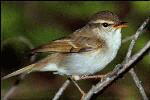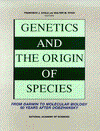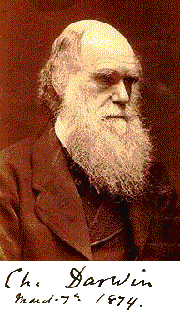|
Introducing Clinal Variation
|
The colored bar shown here represents a group of natural populations. Let's think of them as birds, but they could be any group of animals or plants. The different colors represent clinal variation in a species (subspecies) or group of species. This cline of populations could stretch across a continent from east to west or north to south. Or, they could bend to encircle a lake (B), mountain or the North Pole, or just wander in any direction, perhaps bordering large river systems such as the Amazon. Examples of all these situations are known, and a few will be presented here.



The small yellow areas separating the species or subspecies along my hypothetical clines represent zones of hybridization. They may or may not exist in nature. If they exist they might be very narrow (a mile or km or two) or very extensive. Depending on the extent and nature of the gene flow, if any, between neighboring species in such zones of contact, biologists or taxonomists might consider the neighbors to be two "good" species. Or, the two neighbors (or several populations in the cline) might be lumped together as subspecies of a single polytypic or polymorphic species.
Clinal variation provides scientists, birdwatchers and other students of nature with the opportunity to study and observe evolution in action. Field studies of the interactions between populations often lead biologists to devise laboratory studies to help elucidate and explain what has been observed in nature. Modern genetics has become especially important as a tool for this purpose.
Where possible, I will provide links to scientific papers bearing upon the cases I present below. If you find that the terminology or rational presented here, or in any of these links, is beyond your level of understanding, you might find it worthwhile to visit the following webpages which include glossaries and introductory course material.
Ring Species: Unusual Demonstrations of Speciation : by Darren E. Irwin, perhaps the best explanation on the Internet for the layman, discusses both salamanders and greenish warblers.
What Did Darwin Say About Incipient Species?
Online Biology Dictionary -- Incipient Species
|
|
Examples of Ring Species
|

|
|
Click on map letters to see more accurate representations of the (A) Ensatina Salamander species ring in western North America, (B) the Greenish Warbler species ring around the Tibetan Plateau in Asia, or (C) the circumpolar Larus Gull species ring.
|

Salamander Species Ring in California : By analyzing electrophoretic separations of selected enzymes and studying DNA patterns, the two subspecies Ensatina klauberi and E. eschscholtzi are different species by every definition. This poses a very interesting problem. Should the species E. eschscholtzi be split into two or more species, or be considered a single species? If the species is to be split, where does one draw the line? See this Ensatina range map.
Evolving Before Our Eyes : Songbirds and salamanders bolster Darwin's theory that change in habitat can create two species from one.
Incipient Species Formation in Salamanders of the Ensatina Complex : by D. Wake, 94 (15):7761-7767 (1997). The complex presents a full array of intermediate conditions between well-marked species and geographically variable populations. Geographically differentiated segments represent a diversity of depths of time of isolation and admixture, reflecting the complicated geomorphological history of California.

 Ring Species: The Greenish Warbler : Biologists have demonstrated, in a study of the songs and genetics of a series of interbreeding populations of warblers in central Asia, how one species can diverge into two. Their description of the intermediate forms of two reproductively isolated populations of songbirds that no longer interbreed is the "missing evidence" that Darwin had hoped to use to support his theory of natural selection, but was never able to find. Another article on same topic: Songbird Shows How Evolution Works.
Ring Species: The Greenish Warbler : Biologists have demonstrated, in a study of the songs and genetics of a series of interbreeding populations of warblers in central Asia, how one species can diverge into two. Their description of the intermediate forms of two reproductively isolated populations of songbirds that no longer interbreed is the "missing evidence" that Darwin had hoped to use to support his theory of natural selection, but was never able to find. Another article on same topic: Songbird Shows How Evolution Works.
Evolving Before Our Eyes : Songbirds and salamanders bolster Darwin's theory that change in habitat can create two species from one. Perhaps the best news report on the subject, from the San Francisco Chronicle.
Annotated Map of Greenish Warbler Ring : This may be the best graphic on the Web for explaining this case. It is a part of the news article just above. Also includes the sonagrams mentioned in next listing.
Song Variation in an Avian Ring Species : by D. Irwin, Evolution 54 (3):998�1010 (2000). The song of the Greenish Warbler suggests another possibility, that parallel ecological changes can cause mating signal divergence. The fact that viridanus and plumbeitarsus have converged ecologically and now share the same habitat might imply that ecology has had little role in the divergence of their songs. This is a technical paper.
Speciation in the Round : by D. Wake, Nature 409:299-300 (2001) News and Views. Ring species occur when one species grades into two at the overlap of a circular population distribution. Good examples are rare, but one case has now passed some rigorous tests. See at libraries or through web subscription.
Speciation in a Ring : by Irwin, D. et al., Nature 409:333-337 (2001). These two taxa do not interbreed in central Siberia but are connected by a long chain of intergrading populations encircling the Tibetan Plateau to the south. Molecular data and climatic history imply that the reproductively isolated taxa came into contact following expansions northward around the western and eastern sides of the plateau. Playback experiments show that the two Siberian forms do not recognize each other's songs. Our results show how gradual divergence in a trait involved in mate choice leads to the formation of new species. See at libraries or through web subscription.
|
|
Sibling Species -- "Good Species" or Subspecies?
|
|
Adaptation-driven Incipient Speciation of Drosophila melanogaster : In Israel, substantial genetic differentiation, as great as among species, exists between populations of Drosophila melanogaster inhabiting opposite slopes of a small canyon.
|
|
Reproductive Isolating Mechanisms
|
|

 Reproductive Isolation in Thirteen Generations : Salmon in a US lake split into two separate populations in just 13 generations, or about 60-70 years, researchers have revealed. Until now, it was believed that new species took hundreds or thousands of years to appear. The research paper by Hendry et al., appeared in Science 290 (5491)::516-518. It generated some interesting debate within the scientific community in later correspondence in that journal. News media reports about this paper typically overstated the case as demonstrating observed speciation. What it really demonstrated is the establishment of mating reproductive isolation (as yet incomplete) and genetic divergence reflected in measurable changes in body form. Thus, two of the three critical steps in the process of formation of new species has been and continues to be observed in these salmon.
Reproductive Isolation in Thirteen Generations : Salmon in a US lake split into two separate populations in just 13 generations, or about 60-70 years, researchers have revealed. Until now, it was believed that new species took hundreds or thousands of years to appear. The research paper by Hendry et al., appeared in Science 290 (5491)::516-518. It generated some interesting debate within the scientific community in later correspondence in that journal. News media reports about this paper typically overstated the case as demonstrating observed speciation. What it really demonstrated is the establishment of mating reproductive isolation (as yet incomplete) and genetic divergence reflected in measurable changes in body form. Thus, two of the three critical steps in the process of formation of new species has been and continues to be observed in these salmon.
Salmon: Rapid Evolution of Reproductive Isolation : by Hendry, A. et al., Science 290 (5491):516 (2000). Using DNA microsatellites, population-specific natural tags, and phenotypic variation, we tested for reproductive isolation between two adjacent salmon populations of a common ancestry that colonized divergent reproductive environments (a river and a lake beach). We found evidence for the evolution of reproductive isolation in fewer than 13 generations. This original paper is available at libraries and through web subscription.
Natural Selection and Parallel Speciation in Sympatric Sticklebacks : by Rundle, H. et al., Science 287 (5451):306-308 (2000). Sympatric species of Threespine Sticklebacks inhabit small, low-elevation lakes in coastal

 British Columbia, Canada. These populations are recently derived from the marine Threespine Stickleback, Gasterosteus aculeatus that colonized freshwater after the retreat of the glaciers at the end of the Pleistocene. One species of each sympatric pair is a large-bodied Benthic that feeds on invertebrates in the littoral zone; the other species is a smaller, more slender Limnetic that feeds primarily on plankton in open water. The Benthic and Limnetic from a given lake constitute biological species: they are reproductively isolated by strong assortative mating, ecologically based postmating isolation, and probably sexual selection against hybrid males. Phenotypic differences between sympatric species have a genetic basis and persist over multiple generations in a common laboratory environment. Both comparative and direct experimental evidence indicate that divergent selection caused by competition for resources has contributed to the evolution of these phenotypic differences. See at libraries or through web subscription.
British Columbia, Canada. These populations are recently derived from the marine Threespine Stickleback, Gasterosteus aculeatus that colonized freshwater after the retreat of the glaciers at the end of the Pleistocene. One species of each sympatric pair is a large-bodied Benthic that feeds on invertebrates in the littoral zone; the other species is a smaller, more slender Limnetic that feeds primarily on plankton in open water. The Benthic and Limnetic from a given lake constitute biological species: they are reproductively isolated by strong assortative mating, ecologically based postmating isolation, and probably sexual selection against hybrid males. Phenotypic differences between sympatric species have a genetic basis and persist over multiple generations in a common laboratory environment. Both comparative and direct experimental evidence indicate that divergent selection caused by competition for resources has contributed to the evolution of these phenotypic differences. See at libraries or through web subscription.
Sexual Selection and Speciation in Field Crickets : by Gray, D and W. Cade, Proc. Natl. Acad. Sci. USA 97 (26):14449-14454 (2000). Combined with previous work demonstrating a lack of hybrid inviability, these results suggest that divergent sexual selection may have caused speciation between these taxa.
Natural Selection and the Reinforcement of Mate Recognition : by M. Higgie et al., Science 290 (5491):519-521 (2000). Drosophila serrata and D. birchii have different but overlapping distributions and habitat associations along the east coast of Australia. The two species are sexually isolated by pheromones composed of cuticular hydrocarbons (CHCs) and hybrids are viable and fertile. In this species pair, mate recognition and CHC profile are highly genetically correlated, with genetic variation in CHCs accounting for over 70% of the genetic variation in mate recognition between the two species. Reproductive character displacement evolved within nine generations, indicating that there was strong selection on mate recognition. See at libraries or through web subscription.
Periodical Cicadas : They have a unique life cycle, divided into year classes known as broods. Broods are potential incipient species, isolated in time because the adults never meet. Periodicity of cicada broods results in reproductive isolation among broods, leading to genetic differentiation and incipient speciation.
Genetics and the Origin of Bird Species : How reproductive isolation occurs, by Peter and Rosemary Grant. Proc. Natl. Acad. Sci. USA 94 (15):7768.
|
|
Species Swarms -- Adaptive Radiations
|
|
The Cichlid Fishes : This is a book review as well as the fantastic story of several hundred species of fishes undergoing rapid evolution during the last 12,400 years in Lake Victoria in tropical Africa. The two other great lakes of the rift valley also have their own distinct swarms of these fishes. This page is currently in production.
Darwin's Finches : The species swarm that Darwin almost missed. The Galapagos Islands are home to many distinct species whose ancestors came mainly from mainland South America. This laboratory of evolution (including long-term studies of the finches) helped establish the sciences of biogeography and evolution. And, yes, those finches are still evolving. This page is currently in production.
|
|
Polyploidy: The Secret for Instant Speciation
|
|
Basic Explanation of Polyploidy in Plants : Just like the comparative analysis of morphological features, chromosomal analysis of numerous species and genera points at phylogenetic relations between single species. This website is an extensive resource in botany..
Instant Evolution : All of the plant species that have evolved more than once have done so via a mechanism called polyploidy. A polyploid species is one that has more than two copies of each of its chromosomes. More than half of all land plants species are polyploid, including wheat, corn and cotton. Few animal species are, one notable exception being salmon.
Gray Treefrog and Cope's Gray Treefrog : Hyla versicolor and H. chrysoscelis. They can be differentiated in the field by their calls, and in the laboratory by their chromosome number: H. chrysoscelis is diploid, having two pairs of every chromosome, while H. versicolor is tetraploid, having 4 copies of every chromosome. Data suggests that the tetraploid species evolved from the diploid through chromosomal mutation, in this case a doubling of the number of chromosomes (polyploidy). It is believed that this has happened on several occasions independently of each other in different parts of H. chrysoscelis' range.
The First Evidence of a Tetraploid Rodent : Instant speciation in the Red Viscach Rat in Argentina
|
|
Sources Elsewhere on the Internet
|
|
Observed Instances of Speciation : A FAQ from talkorigins.org, last updated in 1995, describes speciation events mainly in plants and insects. It is not true that speciation has gone unobserved.
Ring Species: Unusual Demonstrations of Speciation : by Darren E. Irwin, perhaps the best explanation on the Internet for the layman, discusses both salamanders and greenish warblers.
|
|
Current Books About Speciation
|
|

 Genetics and the Origin of Species : (NAS Colloquium) From Darwin to Molecular Biology 60 Years After Dobzhansky (1997). All of the papers may be read online.
Genetics and the Origin of Species : (NAS Colloquium) From Darwin to Molecular Biology 60 Years After Dobzhansky (1997). All of the papers may be read online.
Beak of the Finch : A Story of Evolution in Our Time by Jonathan Weiner, $11.90.
Ecology and Evolution of Darwin's Finches : by Peter R. Grant, $22.95.
Evolution and the Diversity of Life : Selected Essays : by Ernst Mayr, $26.00.
Frogs, Flies, and Dandelions : Speciation -- The Evolution of New Species. By Menno Schilthuizen. $22.40.
The Cichlid Fishes: Nature's Grand Experiment in Evolution : by George W. Barlow, $22.40.
|







